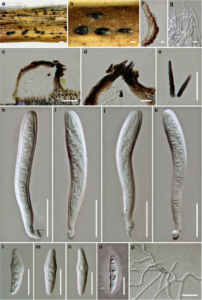Keissleriella dactylidicola Mapook, Camporesi&K.D. Hyde.
Index Fungorum number: IF551391; Facesoffungi number: FoF00941; Fig. 1
Etymology – The specific epithet dactylidicola is named after the host Dactylis.
Holotype – MFLU 15–1518
Saprobic on dead stem of Dactylis sp. Sexual morph: Ascomata (140–) 160 – 210 high, (150–) 200 – 230 μm diam. (x̄ = 176.5 × 203 μm, n = 5), superficial, solitary or scattered, oval to ellipsoidal, globose to subglobose, brown to dark brown, without a subiculum covering the host. Ostiole (15–) 25 – 30 × 3 – 4 μm, slightly protruding, with apical dark brown setae, with blunt or acute apex. Peridium (14–) 15 – 25 (−30) μm wide, comprising 2 – 4 layers, outer layer comprising irregular brown cells, inner layers comprising brown, flattened cells of textura angularis. Hamathecium comprising 1.5 – 2 μm wide, cylindrical to filiform, septate, branched, pseudoparaphyses. Asci (50–) 60 – 80 × 8 – 10 μm (x̄ = 65.5 × 9 μm, n = 10), 8 – spored, bitunicate, cylindric-clavate, slightly curved, with short bulbose pedicel, apically rounded, with a wide ocular chamber. Ascospores 15 – 19 × 4–5 μm (x̄ = 18.5 × 4 μm, n = 10), overlapping 1 – 2 – seriate, hyaline, broadly fusiform, 1 – septate, deeply constricted at the septum, widest at the middle and tapering towards the narrow ends, straight or slightly curved, guttulate, surrounded by hyaline, gelatinous sheath, observed only mounted in Indian ink. Asexual morph: Undetermined.
Material examined – ITALY, Arezzo Province, Papiano – Stia, on dead stem of Dactylis sp. (Poaceae), 27 August 2013, E. Camporesi (MFLU 15–1518, holotype), ex-type living cultures, MFLUCC 13–0866; ITALY, Arezzo Province, Papiano – Stia, on dead stem of Dactylis sp. (Poaceae), 16 September 2013, E. Camporesi (MFLU 15–1519, paratype).
Notes – Keissleriella dactylidicola was collected as a saprobe from dead stems of Dactylis sp. Keissleriella dactylidicola is similar to K. dactylidis but differs in having shorter, dark brown setae and in the size, shape and septation of the ascospores (Supplementary Table 3). Keissleriella dactylidicola is similar to K. caudata E. Müll. (Corbaz 1957) in having apical, dark brown setae and hyaline, 1- septate ascospores, with a sheath. It is distinct from K. caudata in having larger ascomata with dark brown setae and a hyaline, mucilaginous sheath surrounding the ascospores (Supplementary Table 3).

Fig. 1 Keissleriella dactylidicola (holotype) a, b Appearance of oval ascomata on the host tissue c Section through ascoma d Ostiole with external, dark brown setae e Dark brown setae f Peridium g Pseudoparaphyses h – k Immature and mature asci l – n Ascospores o Ascospore in Indian ink surrounded by hyaline gelatinous sheath p Germinating ascospore. Scale bars: a = 500 μm, b = 200 μm, c = 50 μm, d, e, h – k = 20 μm, f, l – p = 10 μm, g = 5 μm.
